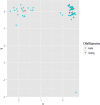Identification of Copy Number Variations in Xiang and Kele Pigs
- PMID: 26840413
- PMCID: PMC4740446
- DOI: 10.1371/journal.pone.0148565
Identification of Copy Number Variations in Xiang and Kele Pigs
Abstract
Xiang and Kele pigs are two well-known local Chinese pig breeds that possess rich genetic resources and have enormous economic and scientific value. We performed a comprehensive genomic analysis of the copy number variations (CNVs) in these breeds. CNVs are one of the most important forms of genomic variation and have profound effects on phenotypic variation. In this study, PorcineSNP60 genotyping data from 98 Xiang pigs and 22 Kele pigs were used to identify CNVs. In total, 172 candidate CNV regions (CNVRs) were identified, ranging from 3.19 kb to 8175.26 kb and covering 80.41 Mb of the pig genome. Approximately 56.40% (97/172) of the CNVRs overlapped with those identified in seven previous studies, and 43.60% (75/172) of the identified CNVRs were novel. Of the identified CNVRs, 82 (47 gain, 33 loss, and two gain-loss events that covered 4.58 Mb of the pig genome) were found only in a Xiang population with a large litter size. In contrast, 13 CNVRs (8 gain and 5 loss events) were unique to a Xiang population with small litter sizes, and 30 CNVRs (14 loss and 16 gain events) were unique to Kele pigs. The CNVRs span approximately 660 annotated Sus scrofa genes that are significantly enriched for specific biological functions, such as sensory perception, cognition, reproduction, ATP biosynthetic processes, and neurological processes. Many CNVR-associated genes, particularly the genes involved in reproductive traits, differed between the Xiang populations with large and small litter sizes, and these genes warrant further investigation due to their importance in determining the reproductive performance of Xiang pigs. Our results provide meaningful information about genomic variation, which may be useful in future assessments of the associations between CNVs and important phenotypes in Xiang and Kele pigs to ultimately help protect these rare breeds.
Conflict of interest statement
Figures


Similar articles
-
Genome wide copy number variations using Porcine 60K SNP Beadchip in Landlly pigs.Anim Biotechnol. 2023 Nov;34(6):1891-1899. doi: 10.1080/10495398.2022.2056047. Epub 2022 Apr 4. Anim Biotechnol. 2023. PMID: 35369845 Review.
-
Genome-wide detection of CNV regions and their potential association with growth and fatness traits in Duroc pigs.BMC Genomics. 2021 May 8;22(1):332. doi: 10.1186/s12864-021-07654-7. BMC Genomics. 2021. PMID: 33964879 Free PMC article.
-
Copy number variation detection using SNP genotyping arrays in three Chinese pig breeds.Anim Genet. 2015 Apr;46(2):101-9. doi: 10.1111/age.12247. Epub 2015 Jan 15. Anim Genet. 2015. PMID: 25590996
-
Identification of genome-wide copy number variations among diverse pig breeds by array CGH.BMC Genomics. 2012 Dec 24;13:725. doi: 10.1186/1471-2164-13-725. BMC Genomics. 2012. PMID: 23265576 Free PMC article.
-
Functional analysis of litter size and number of teats in pigs: From GWAS to post-GWAS.Theriogenology. 2022 Nov;193:157-166. doi: 10.1016/j.theriogenology.2022.09.005. Epub 2022 Sep 19. Theriogenology. 2022. PMID: 36209572
Cited by
-
A genome-wide single nucleotide polymorphism and copy number variation analysis for number of piglets born alive.BMC Genomics. 2019 Apr 27;20(1):321. doi: 10.1186/s12864-019-5687-0. BMC Genomics. 2019. PMID: 31029102 Free PMC article.
-
About the existence of common determinants of gene expression in the porcine liver and skeletal muscle.BMC Genomics. 2019 Jun 24;20(1):518. doi: 10.1186/s12864-019-5889-5. BMC Genomics. 2019. PMID: 31234802 Free PMC article.
-
Genome-Wide Detection of Copy Number Variations and Evaluation of Candidate Copy Number Polymorphism Genes Associated With Complex Traits of Pigs.Front Vet Sci. 2022 Jun 30;9:909039. doi: 10.3389/fvets.2022.909039. eCollection 2022. Front Vet Sci. 2022. PMID: 35847642 Free PMC article.
-
Whole-genome sequence analysis reveals selection signatures for important economic traits in Xiang pigs.Sci Rep. 2022 Jul 12;12(1):11823. doi: 10.1038/s41598-022-14686-w. Sci Rep. 2022. PMID: 35821031 Free PMC article.
-
Genome-wide detection of multiple variants associated with teat number in French Yorkshire pigs.BMC Genomics. 2024 Jul 25;25(1):722. doi: 10.1186/s12864-024-10611-9. BMC Genomics. 2024. PMID: 39054457 Free PMC article.
References
-
- Yang H, Li F, Kong X, Yuan X, Lian G, Geng M, et al. Molecular cloning, tissue distribution and ontogenetic expression of Xiang pig chemerin and its involvement in regulating energy metabolism through Akt and ERK1/2 signaling pathways. Molecular Biology Reports. 2012;39(2):1887–1894. 10.1007/s11033-011-0934-8 - DOI - PubMed
-
- Amills M, Clop A, Ramírez O, Pérez Enciso M. Origin and genetic diversity of pig breeds. eLS. 2010.
Publication types
MeSH terms
LinkOut - more resources
Full Text Sources
Other Literature Sources
Miscellaneous

